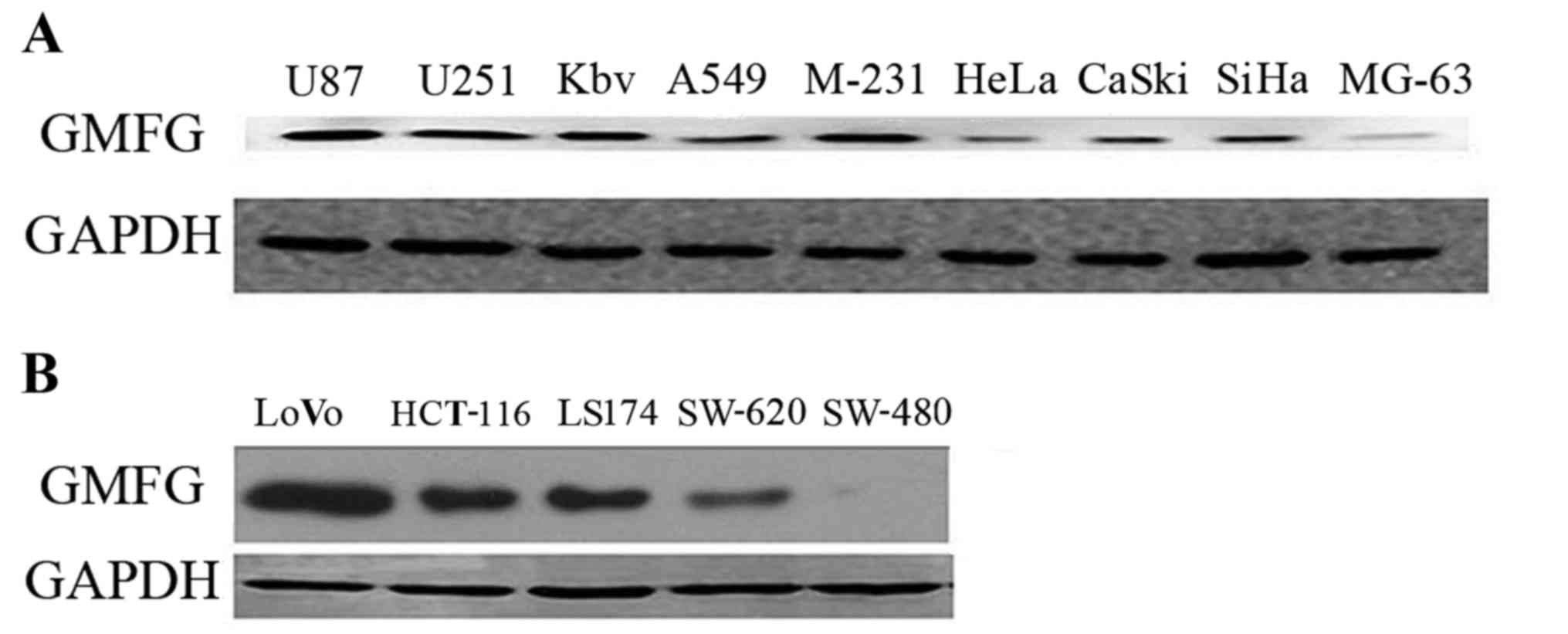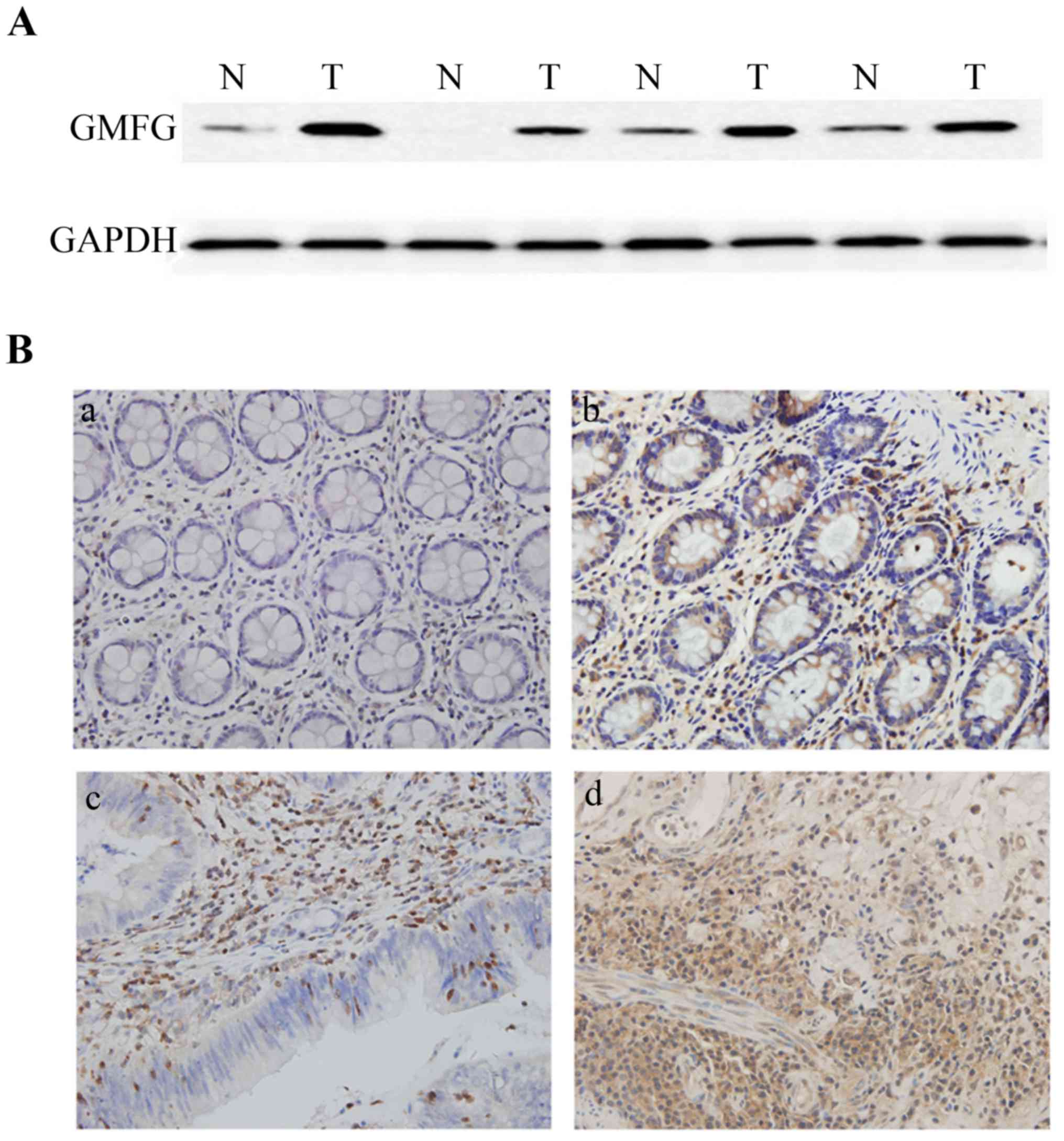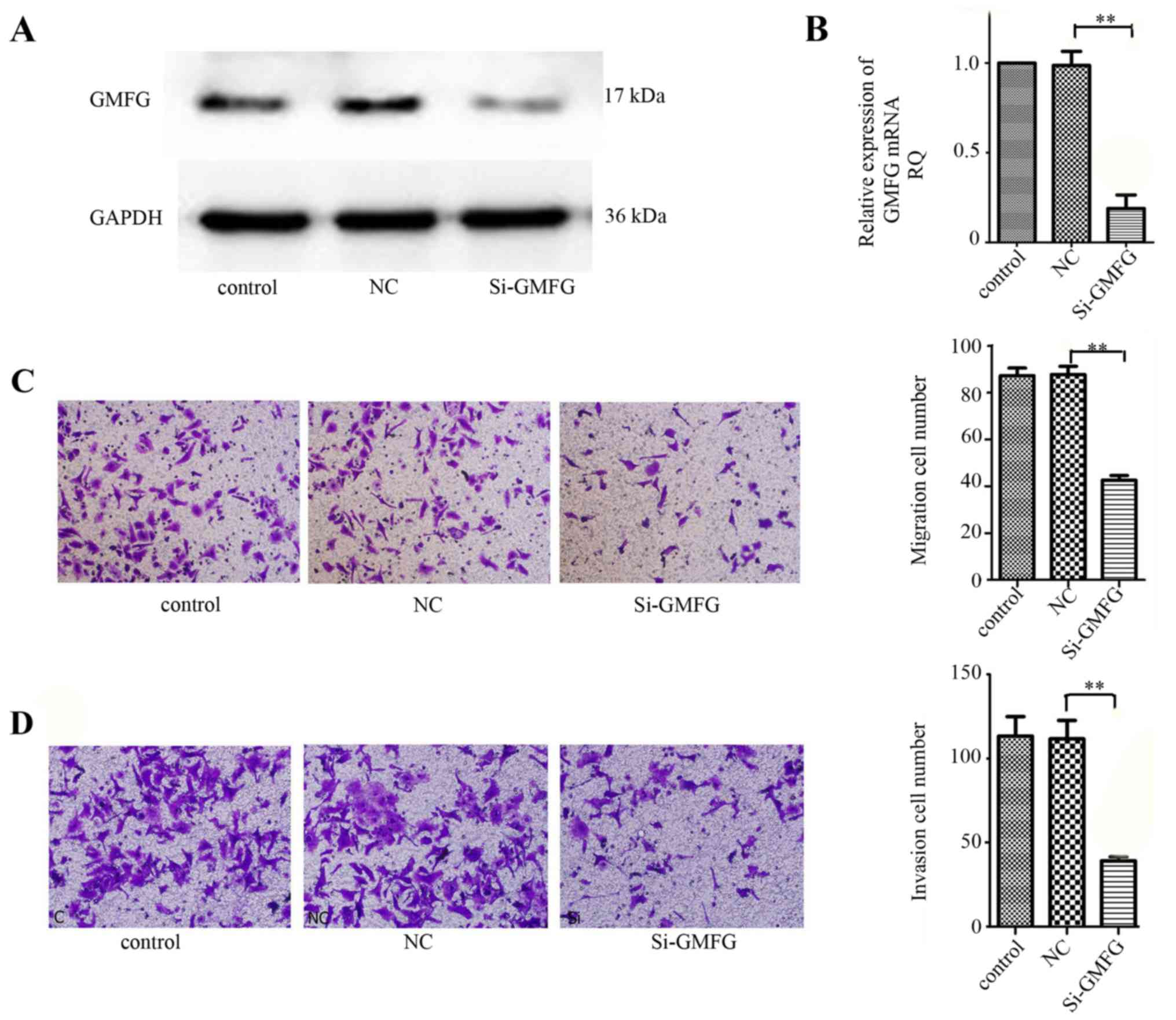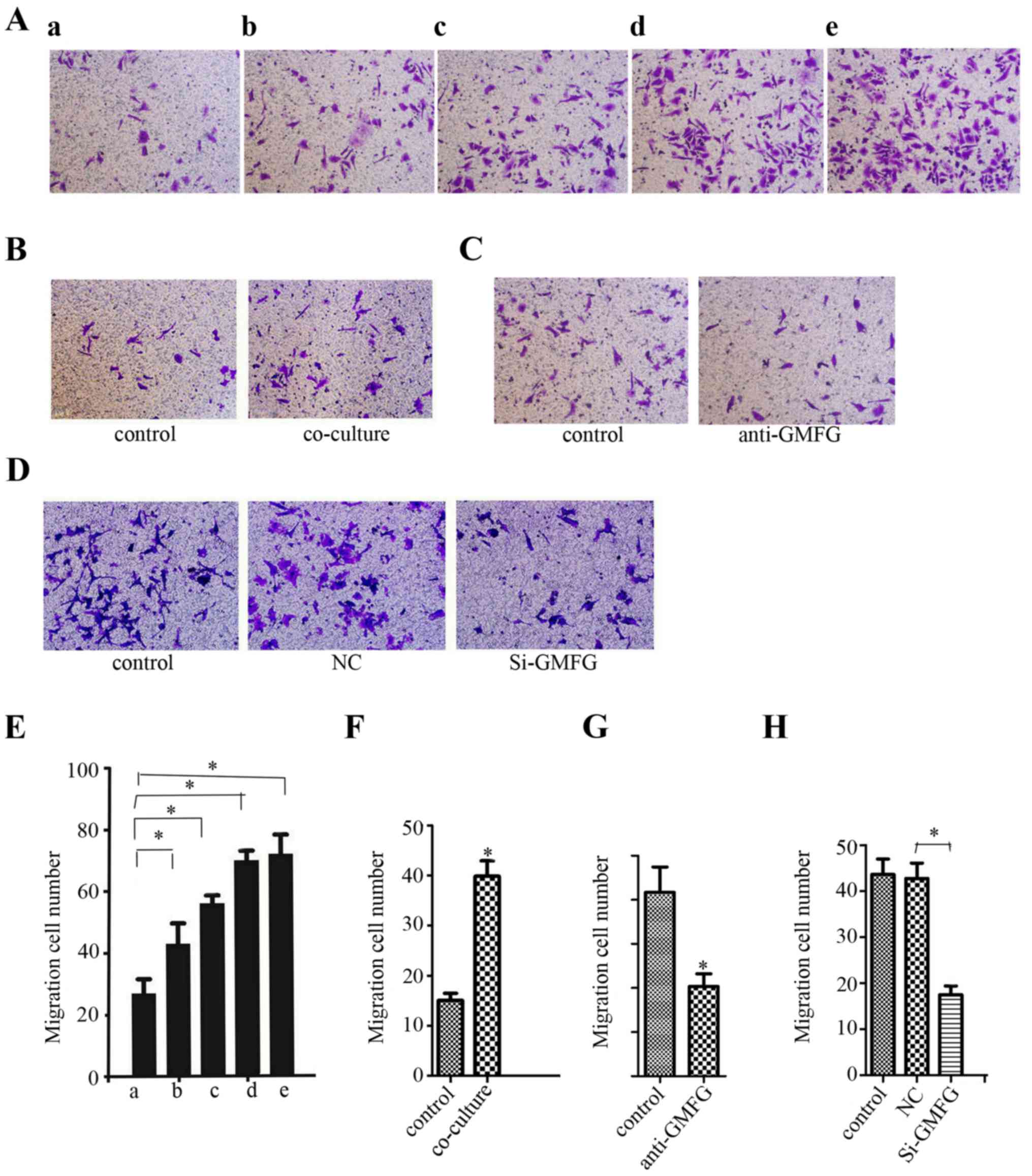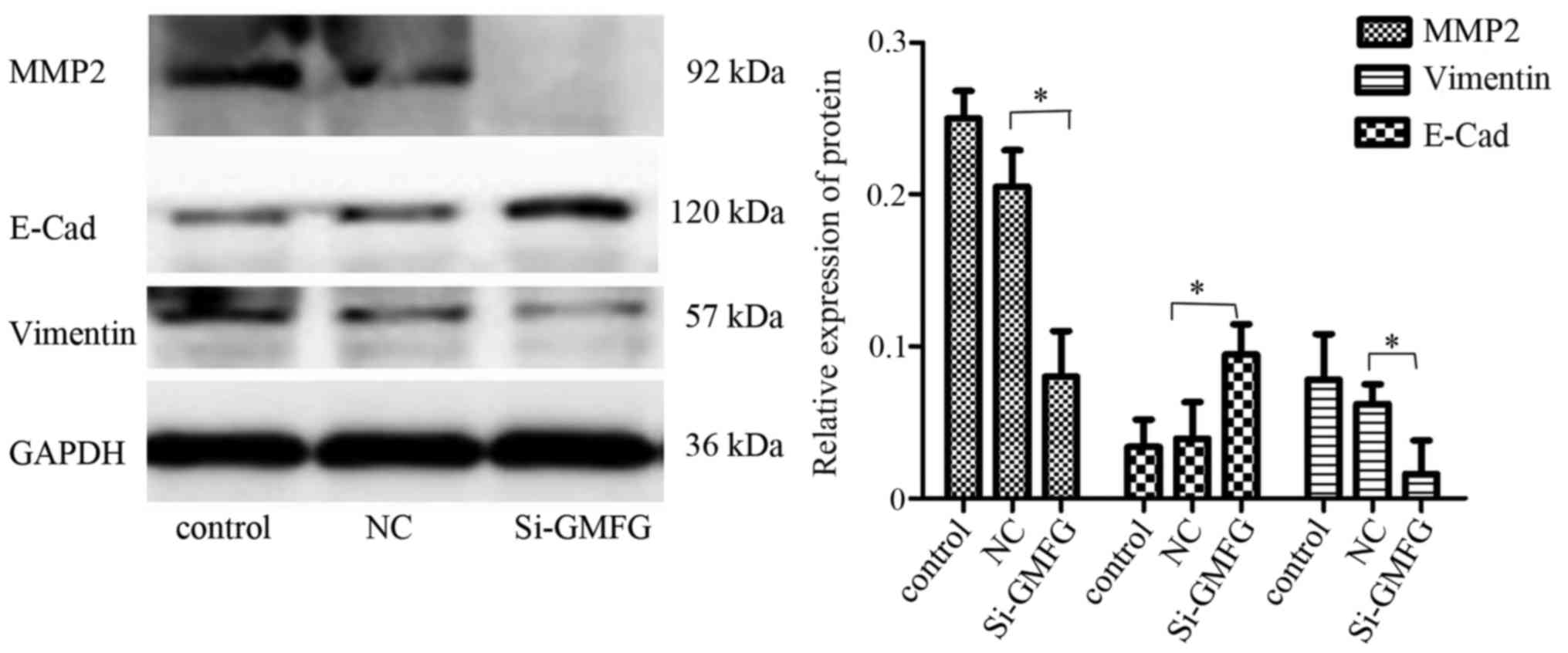Expression of glia maturation factor γ is associated with colorectal cancer metastasis and its downregulation suppresses colorectal cancer cell migration and invasion in vitro
- Authors:
- Published online on: January 9, 2017 https://doi.org/10.3892/or.2017.5361
- Pages: 929-936
Abstract
Introduction
Colorectal cancer is the third most commonly occurring cancer worldwide and accounts for the third highest cancer-related mortality rate in the US (1,2). Colorectal cancer development may take decades by transformation of normal epithelial cells to invasive tumor cells and involves many genetic alterations and is influenced by many environmental factors. Dr Vogelstein illustrated decades ago a model of the adenoma-carcinoma sequence with gene alterations (3–5). Clinically, ~65% of colorectal cancer patients survive for an average of 5 years (1,2). However, when diagnosed with early stages and localized disease, the 5-year survival rate can reach 90.3%, while the survival rate may be reduced to only 12.5% when patients are diagnosed with advanced stages with tumor distant metastasis (6,7). The most common metastatic sites include the liver and peritonea and ~20% of patients have liver metastases at the first diagnosis of colorectal (8–10). Moreover, tumor metastasis accounts for the majority of cancer-related deaths, and only 40% of patients are implicated to receive curable surgery. Thus, it is urgent to search for and identify novel biomarkers for the early detection of colorectal cancer, particularly for detection of tumor metastasis and progression.
Glia maturation factor γ (GMFG) is a 17-kDa protein and the GMF family of proteins includes GMFB and GMFG (11–14). GMFG levels are detectable in sera of healthy individuals without obvious difference between women and men and are enriched in various human organs, such as the thymus, spleen and colon (15). Structurally, GMFG protein belongs to the ADF/cofilin family and can modulate actin cytoskeleton reorganization in microvascular endothelial, human airway smooth muscle and ovarian cancer cells (16,17). Moreover, GMFG can affect Toll-like receptor 4 (TLR4) signaling in macrophages, regulate chemotaxis of neutrophil and T lymphocytes (18,19), and affect the angiogenic sprouting in zebra fish (20). Taken together, GMFG could regulate cell mobility and angiogenesis and therefore, we speculated that GMFG could play a role in cancer metastasis. Indeed, Zuo et al (14) showed that GMFG expression was able to influence migration and invasion of epithelial ovarian cancer. In addition, alteration and reduction in epithelial cell adhesion ability enhance epithelial-mesenchymal transition (EMT), and contribute to tumor cell migration, invasion and metastasis. E-cadherin (E-Cad) has the ability to regulate cell adhesion, whereas vimentin is usually overexpressed in carcinoma cells (21–23) and the matrix metalloproteinase (MMPs) family is critical in the modulation of tumor cell invasion and metastasis, particularly MMP2 and MMP9 (24), since these MMPs are enzymes that can digest collagen I and IV and laminin in the extracellular matrix (25–27). A previous study demonstrated that aberrant MMP2 gene-phenotype was associated with colorectal cancer prognosis (28).
In the present study, we first assessed GMFG expression in colorectal cancer cells and tissue specimens, and then explored the role of GMFG in the regulation of colorectal cancer cell migration and invasion. We aimed to provide insightful information in order to emphasize that detection of GMFG expression is a valuable biomarker with which to diagnose colorectal cancer metastasis and predict tumor progression.
Materials and methods
Cancer cell lines and colorectal cancer tissues
Different human cancer cell lines LoVo, HCT-116, LS174T, SW-620, SW-480, U87, U251, KBV, A549, MDA-231, HeLa, CaSki, SiHa, and MG-63 were obtained from the Research Center of Clinical Medicine, Nanfang Hospital (Guangzhou, China) and were maintained in Dulbecco's modified Eagle's medium (DMEM) containing 10% fetal bovine serum (FBS) (both from HyClone, Logan, UT, USA) in a humidified incubator with 5% CO2 at 37°C.
Colorectal cancer tissue specimens were obtained from 68 patients who received surgery for tumor resection in Nanfang Hospital between December 2011 and January 2013. These patients did not receive any treatments before surgery and all cases were histologically diagnosed and retrospectively reviewed by two pathologists in the present study. The present study was approved by the Human Ethics Committee of Nanfang Hospital. In the present study, we collected paired normal and colorectal cancer tissue specimens and clinicopathological data from each patient. Tissue samples were stored in liquid nitrogen until use according to our previous study (29). Among these patients, 24 patients had rectal cancer and 44 had colon cancer, while 40 were at early stages of disease without tumor metastasis while 28 had different degrees of tumor metastasis according to the standard of the National Comprehensive Cancer Network (NCCN). The clinicopathological characteristics of the patients are presented in Table I.
Table I.GMFG expression and its association with the clinicopathological data from the colorectal cancer patients. |
Protein extraction and western blotting
Different cancer cell lines were grown and then collected from cell culture plates after being washed with phosphate-buffered saline (PBS) 3 times and lysed in a lysis buffer containing 50 mM Tris (pH 7.4), 150 mM NaCl, 1% sodium deoxycholate, 0.1% sodium dodecyl sulfate and phosphorylase and metalloproteinase inhibitor (Beyotime, Inc., Beijing, China). Colorectal tumor tissues were grinded on ice and then lysed in the same lysis buffer. Both types of cell lysis were then centrifuged and the concentration of protein samples was measured using the BCA protein assay kit (Beyotime). The protein samples were then treated with 5X loading buffer and boiled at 100°C for 5 min, separated using sodium dodecyl sulfate-polyacrylamide gel electrophoresis (SDS-PAGE) on 12% SDS-PAGE gels and transferred onto polyvinylidene fluoride (PVDF) membranes (Millipore, Billerica, MA, USA). The membranes were then blocked in 5% skim milk solution in PBS and then incubated with different primary anti-human antibodies at 4°C overnight and the secondary antibody and enhanced chemiluminescence (ECL) kit according to a standard protocol. The primary antibodies were anti-GAPDH (1:1,000), anti-GMFG (1:1,000) (both from ProteinTech Group, Wuhan, China), anti-MMP2 (1:1,000), anti-E-Cad (1:1,000) and anti-vimentin (1:1,000) (all from Abcam, Cambridge, MA, USA).
Immunohistochemistry
Paraffin-embedded tissue specimens were sectioned into 4-µm thick sections and put onto 3-aminopropyltriethoxysilane (APES)-coated glass slides. For immunohistochemistry, the sections were deparaffinized in xylene and rehydrated in a series of ethanol solution and submerged in tap-water. The antigen retrieval was then performed using an antigen unmasking solution, which was preheated in a microwave for 5 min and the sections in the buffer were heated at highest energy levels for 8 min in a microwave and cooled down to room temperature. Potential endogenous peroxidase activity was blocked in 3% hydrogen peroxide for 20 min and the sections were incubated in 5% casein in PBS for 1 h to block non-specific antibody binding. The sections were then incubated at 4°C overnight with a rabbit anti-GMFG antibody (ProteinTech) at a dilution of 1:100 and subjected to a post primary block using the polymer penetration enhancer (Boshide, Wuhan, China) for 30 min. Sections were then washed with PBS 5 min each for 3 times and further incubated at room temperature for 30 min with an anti-rabbit IgG-Poly-HRP (Merck, Kenilworth, NJ, USA). The sections were visualized with 3,3′-diaminobenzidine (DAB) solution (Boshide) and briefly counterstained with hematoxylin solution.
The immunostained sections were reviewed and scored by two investigators under a light microscope for intensity and percentage of staining. Protein localization was evaluated and classified as nuclear, cytoplasmic and plasmalemma locations. The percentage of positively stained tumor cells was graded as 0–10% (1+), 11–50% (2++) and >50% stained cells (3+++), while the staining intensity was graded as 1 (weakly positive), 2 (positive) and 3 (strongly positive). Subsequently, an immunostaining index was calculated by multiplying the staining intensity with the percentage of positive cells to reach negative (0), weak (1+), medium (2++) and strong (3+++) expression of GMFG (Table I).
Quantitative reverse transcription-polymerase chain reaction (RT-qPCR)
Total RNA was isolated from cells using TRIzol reagent (Invitrogen, Carlsbad, CA, USA) and reversely transcribed into cDNA using 5X PrimeScript RT Master Mix (Takara, Dalian, China) according to the manufacturers protocols. After that, these cDNA samples were subjected to qPCR amplification using 2X SYBR Premix Ex Taq (Takara) in the 7500 ABI Real-Time PCR System (Applied Biosystems, Foster City, CA, USA). The amplification conditions were 95°C for 30 sec, 95°C for 5 sec, and 60°C for 34 sec for 40 cycles and the relative level of mRNA expression was calculated using the 2−ΔΔCt method after normalization to the level of GAPDH mRNA. The primers used were: GMFG, 5′-CGC GGG AAG TAA AAA CAGG C-3′ and 5′-GGT CTC GTT GAG GTC GTC TG-3′; and GAPDH, 5′-AGA AGG TGG GGC TCA TTT G-3 and 5-AGG GGC CAT CCA CAGT CTT C-3′.
GMFG RNA interference
To knockdown GMFG expression in colorectal cancer cells, we used GMFG siRNA purchased from Ruibo Co. (Guangzhou, China) and transfected GMFG siRNA or negative control (NC) siRNA into the colorectal cells for 24 h using Hylimax (Dojindo, Kumamoto, Japan) in Opti-MEM (Thermo Fisher Scientific, Waltham, MA, USA) according to the manufacturer's instructions and assayed. The NC siRNA was random siRNA duplex sequences.
Tumor cell migration and invasion assays
For the migration assay, 5×104 cells in a serum-free medium were seeded onto an uncoated filter with 8.0-µm pores (Corning, Corning, NY, USA), whereas 1×105 cells were seeded onto a filter with 8.0 mm pores precoated the extracellular matrix (BD Biosciences, Franklin Lakes, NJ, USA) for the invasion assays. The bottom chambers were filled with 10% FBS and cultured for 24 h. In separated experiments, different concentrations of recombinant GMFG (0, 5, 10, 20 and 30 µg/ml) were added into the bottom chambers. At the end of the experiments, cells on the surface of the filters were removed using cotton swabs and PBS, while cells that had migrated or invaded into the low surface of the filters were fixed and stained with crystal violet (Beyotime). The numbers of migrated and invaded cells were counted under a microscope for 10 of 20x microscopic fields and averaged.
ELISA detection of GMFG in cell culture medium
The level of GMFG in cell culture medium was measured using the GMFG ELISA kit (Cusabio Biotech Co., Ltd., Wuhan, China) according to the manufacturer's protocol. GMFG levels were expressed as mean ± SD of triplicate experiments and repeated at least 3 times.
Statistical analysis
Statistical analyses were performed using the SPSS 13.0 statistical software (SPSS, Chicago, IL, USA). The data are expressed as mean ± SD and were statistically analyzed using one-way ANOVA and χ2 test. P<0.05 indicates statistically significant results.
Results
Expression of GMFG in different cancer cell lines and colorectal cancer tissue specimens
In the present study, we first detected GMFG expression in 14 different cancer cell lines and found that GMFG was expressed in the majority of the cell lines (Fig. 1A). GMFG protein was preferentially expressed in U87, U251, KBV, MDA-231, SiHa and LoVo cells, while colorectal cancer cell line LoVo expressed the highest level of GMFG compared with the other cell lines (Fig. 1B).
We then analyzed GMFG expression in 68 colorectal cancer surgical samples and found that 42 samples (61.8%) expressed a high level of GMFG protein using western blotting compared with the adjacent non-tumor tissues, while 14 samples (20.6%) showed no obvious difference, whereas 12 samples (17.6%) had lower levels of GMFG compared with normal tissues (Fig. 2A).
Immunohistochemical data showed that GMFG was highly expressed in colorectal tissues compared to normal tissues (Fig. 2B). GMFG protein was mainly localized in mesenchymal cells of the non-tumor colorectal tissues and in the gland cells in the tumor tissues. We then associated GMFG expression with clinicopathological parameters from these patients and found that GMFG was associated with lymph node metastasis (85.7 vs. 57.5% in non-metastatic cases; Table I), but there was no statistically significant difference in GMFG expression associated with patient gender and age and tumor differentiation (Table I).
Suppression of LoVo cell migration and invasion abilities after knockdown of GMFG expression
We then assessed the effects of GMFG knockdown in colorectal cancer cells using GMFG siRNA. Our data showed that GMFG siRNA significantly silenced GMFG expression in the LoVo cells (Fig. 3A and B). We then performed the Transwell assay to assay the altered ability of tumor cell migration and invasion, and found that both tumor cell migration and invasion capacities were reduced after knockdown of GMFG expression (Fig. 3C and D).
Induction of LoVo cell migration and invasion by exogenous GMFG treatment
We further determined whether addition of exogenous GMFG could affect LoVo cell migration. As shown in Fig. 4A, the number of LoVo cells was increased after addition of exogenous GMFG and the maximal GMFG concentration was 20 µg/ml, although the level of LoVo cell migration did not obviously increase as GMFG concentration continued to rise.
Induction of LoVo cell migration after co-culture with HUVECs
As discussed in the Introduction section, GMFG can promote angiogenesis. We, thus, co-cultured LoVo cells with human umbilical vein endothelial cells (HUVECs). Our data showed that the migration capacity of the LoVo cells was increased after being co-cultured with the HUVECs (Fig. 4B). However, addition of the GMFG antibody into this co-culture downregulated LoVo cell migration (Fig. 4C). Moreover, knockdown of GMFG expression in HUVECs and then co-culture with LoVo cells showed a decrease in LoVo cell migration compared with the NC group (Fig. 4D). However, we failed to detect GMFG levels in cell culture medium in our cancer cell lines by using GMFG ELISA kit (data not shown).
Inhibition of MMP2 expression and reversal of EMT after knockdown of GMFG expression in LoVo cells
Western blot analysis revealed that knockdown of GMFG expression downregulated expression of E-Cad and MMP2, but upregulated the vimentin level in the LoVo cells (Fig. 5), indicating that GMFG promoted tumor cell EMT while silencing of GMFG reversed the EMT phenotype in the LoVo cells.
Discussion
In the present study, we first assessed GMFG expression in colorectal cancer cell lines and tissue specimens, and then explored the role of GMFG in the regulation of colorectal cancer cell migration and invasion in vitro. We found that GMFG protein was expressed in 14 different common human cancer cell lines and the highest GMFG level was noted in colorectal cancer LoVo cell line. Furthermore, we also found that GMFG was highly expressed in colorectal cancer tissue samples, particularly in patients with lymph node metastasis (85.7 vs. 57.5% of non-metastatic patients). However, knockdown of GMFG expression or anti-GMFG antibody reduced the migration and invasion abilities of the LoVo cells, whereas GMFG treatment induced LoVo cell migration capacity, which is consistent with a recent study reported by Zuo et al who demonstrated that GMFG expression promoted migration and invasion of epithelial ovarian cancer cells (14). In addition, our current data also showed that knockdown of GMFG expression altered expression of tumor EMT-related proteins, such as MMP2, E-cadherin and vimentin. Since GMFG protein functions to reorganize the actin cytoskeleton and previous studies have shown that GMFG induced the migration of human T lymphocytes (16,19), our current data suggest that GMFG-induced colorectal cancer cell migration and invasion could be through GMFG-altered tumor cell EMT, although future study is needed to confirm this.
Furthermore, the LoVo cell line was derived from a patient with metastatic colon cancer and has a high ability to invade and metastasize, while the SW480 cell line was established from a patient with primary colon adenocarcinoma. The present study showed that expression of GMFG protein was higher in the LoVo cells than that in the SW480 cell line. In tissue samples, we also found a similar phenomenon, i.e., GMFG protein was higher in tissues with metastatic colorectal cancer. These results suggest that detection of GMFG protein could be used as a biomarker for detection of colorectal cancer, particularly, metastatic colorectal cancer.
Previous studies have confirmed that EMT is an important early step in the conversion of tumor cells into a migratory population capable of systemic tumor metastasis (30–32). At the molecular level, EMT is associated with a gain in mesenchymal markers, including vimentin and N-cadherin but a loss of adherent junction proteins, such as E-cadherin (33–36). In the present study, we found that knockdown of GMFG expression upregulated E-cadherin expression but downregulated vimentin and MMP2 expression in LoVo cells. To the best of our knowledge, MMP2 is a key protein in the process of tumor cell migration and invasion (37–39). Our current finding provides a more plausible explanation for highly expressed GMFG protein in most colorectal cancer tissues. However, it is true that we do not know the mechanism of how GMFG mediated alteration of the expression of these proteins. This mechanism could involve GMFG activation of cell receptors or modulation of integrin expression or functions. Regardless, the targeting of GMFG expression or function may be a novel strategy by which to control colorectal cancer progression.
In addition, the present study for the first time confirmed that exogenous GMFG treatment promoted colorectal cancer cell migration and that co-culture of LoVo cells with HUVECs also promoted tumor cell migration, whereas knockdown of GMFG expression or anti-GMFG antibody decreased colorectal cancer migration. We then assessed whether HUVECs could secrete GMFG into the cell culture medium to play its role in the promotion of colorectal cancer cell migration. However, we could not detect expression of GMFG in the culture media, although we cannot exclude the role of secreted GMFG in the regulation of colorectal cancer migration and invasion, which may be due to the fact that ELISA was unable to detect the low GMFG level in the growth media. Thus, we will continue to investigate the underlying molecular mechanism by which GMFG modulates colorectal cancer invasion and metastasis.
In conclusion, the present study demonstrated that GMFG expression is associated with colorectal cancer metastasis to lymph nodes ex vivo and knockdown of GMFG expression or the anti-GMFG antibody could reduce tumor cell migration and invasion in vitro. Thus, GMFG should be further evaluated as a diagnostic marker in the early detection of colorectal cancer metastasis. The targeting of GMFG expression may suppress colorectal cancer progression.
Glossary
Abbreviations
Abbreviations:
|
GMFG |
glia maturation factor γ |
|
MMP2 |
matrix metalloproteinase 2 |
|
EMT |
epithelial-mesenchymal transition |
|
E-Cad |
E-cadherin |
|
ADF |
actin-depolymerizing factor |
References
|
Siegel RL, Miller KD and Jemal A: Cancer statistics, 2016. CA Cancer J Clin. 66:7–30. 2016. View Article : Google Scholar : PubMed/NCBI | |
|
Ferlay J, Steliarova-Foucher E, Lortet-Tieulent J, Rosso S, Coebergh JW, Comber H, Forman D and Bray F: Cancer incidence and mortality patterns in Europe: Estimates for 40 countries in 2012. Eur J Cancer. 49:1374–1403. 2013. View Article : Google Scholar : PubMed/NCBI | |
|
Shih IM, Zhou W, Goodman SN, Lengauer C, Kinzler KW and Vogelstein B: Evidence that genetic instability occurs at an early stage of colorectal tumorigenesis. Cancer Res. 61:818–822. 2001.PubMed/NCBI | |
|
Höglund M, Gisselsson D, Hansen GB, Säll T, Mitelman F and Nilbert M: Dissecting karyotypic patterns in colorectal tumors: Two distinct but overlapping pathways in the adenoma-carcinoma transition. Cancer Res. 62:5939–5946. 2002.PubMed/NCBI | |
|
Hagland HR, Berg M, Jolma IW, Carlsen A and Søreide K: Molecular pathways and cellular metabolism in colorectal cancer. Dig Surg. 30:12–25. 2013. View Article : Google Scholar : PubMed/NCBI | |
|
Howlader N, Noone AM, Krapcho M, Garshell J, Neyman N, Altekruse SF, Kosary CL, Yu M, Ruhl J, Tatalovich Z, et al: SEER Cancer Statistics Review, 1975–2010. National Cancer Institute; Bethesda, MD: 2013, http://seer.cancer.gov/csr/1975_2010/ | |
|
DeBerardinis RJ, Lum JJ, Hatzivassiliou G and Thompson CB: The biology of cancer: Metabolic reprogramming fuels cell growth and proliferation. Cell Metab. 7:11–20. 2008. View Article : Google Scholar : PubMed/NCBI | |
|
Willett WC: Diet and cancer: An evolving picture. JAMA. 293:233–234. 2005. View Article : Google Scholar : PubMed/NCBI | |
|
de Jong AE, Morreau H, Nagengast FM, Mathus-Vliegen EM, Kleibeuker JH, Griffioen G, Cats A and Vasen HF: Prevalence of adenomas among young individuals at average risk for colorectal cancer. Am J Gastroenterol. 100:139–143. 2005. View Article : Google Scholar : PubMed/NCBI | |
|
Haggar FA and Boushey RP: Colorectal cancer epidemiology: Incidence, mortality, survival, and risk factors. Clin Colon Rectal Surg. 22:191–197. 2009. View Article : Google Scholar : PubMed/NCBI | |
|
Mao M, Fu G, Wu JS, Zhang QH, Zhou J, Kan LX, Huang QH, He KL, Gu BW, Han ZG, et al: Identification of genes expressed in human CD34+ hematopoietic stem/progenitor cells by expressed sequence tags and efficient full-length cDNA cloning. Proc Natl Acad Sci USA. 95:8175–8180. 1998. View Article : Google Scholar : PubMed/NCBI | |
|
Asai K, Fujita K, Yamamoto M, Hotta T, Morikawa M, Kokubo M, Moriyama A and Kato T: Isolation of novel human cDNA (hGMF-gamma) homologous to Glia Maturation Factor-beta gene. Biochim Biophys Acta. 1396:242–244. 1998. View Article : Google Scholar : PubMed/NCBI | |
|
Shi Y, Chen L, Liotta LA, Wan HH and Rodgers GP: Glia maturation factor gamma (GMFG): A cytokine-responsive protein during hematopoietic lineage development and its functional genomics analysis. Genomics Proteomics Bioinformatics. 4:145–155. 2006. View Article : Google Scholar : PubMed/NCBI | |
|
Zuo P, Ma Y, Huang Y, Ye F, Wang P, Wang X, Zhou C, Lu W, Kong B and Xie X: High GMFG expression correlates with poor prognosis and promotes cell migration and invasion in epithelial ovarian cancer. Gynecol Oncol. 132:745–751. 2014. View Article : Google Scholar : PubMed/NCBI | |
|
Inagaki M, Aoyama M, Sobue K, Yamamoto N, Morishima T, Moriyama A, Katsuya H and Asai K: Sensitive immunoassays for human and rat GMFB and GMFG, tissue distribution and age-related changes. Biochim Biophys Acta. 1670:208–216. 2004. View Article : Google Scholar : PubMed/NCBI | |
|
Ikeda K, Kundu RK, Ikeda S, Kobara M, Matsubara H and Quertermous T: Glia maturation factor-gamma is preferentially expressed in microvascular endothelial and inflammatory cells and modulates actin cytoskeleton reorganization. Circ Res. 99:424–433. 2006. View Article : Google Scholar : PubMed/NCBI | |
|
Wang T, Cleary RA, Wang R and Tang DD: Glia maturation factor-γ phosphorylation at Tyr-104 regulates actin dynamics and contraction in human airway smooth muscle. Am J Respir Cell Mol Biol. 51:652–659. 2014. View Article : Google Scholar : PubMed/NCBI | |
|
Aerbajinai W, Liu L, Chin K, Zhu J, Parent CA and Rodgers GP: Glia maturation factor-γ mediates neutrophil chemotaxis. J Leukoc Biol. 90:529–538. 2011. View Article : Google Scholar : PubMed/NCBI | |
|
Lippert DN and Wilkins JA: Glia maturation factor gamma regulates the migration and adherence of human T lymphocytes. BMC Immunol. 13:212012. View Article : Google Scholar : PubMed/NCBI | |
|
Zuo P, Fu Z, Tao T, Ye F, Chen L, Wang X, Lu W and Xie X: The expression of glia maturation factors and the effect of glia maturation factor-γ on angiogenic sprouting in zebrafish. Exp Cell Res. 319:707–717. 2013. View Article : Google Scholar : PubMed/NCBI | |
|
Satelli A and Li S: Vimentin in cancer and its potential as a molecular target for cancer therapy. Cell Mol Life Sci. 68:3033–3046. 2011. View Article : Google Scholar : PubMed/NCBI | |
|
Arias AM: Epithelial mesenchymal interactions in cancer and development. Cell. 105:425–431. 2001. View Article : Google Scholar : PubMed/NCBI | |
|
Bates RC and Mercurio AM: The epithelial-mesenchymal transition (EMT) and colorectal cancer progression. Cancer Biol Ther. 4:365–370. 2005. View Article : Google Scholar : PubMed/NCBI | |
|
Turpeenniemi-Hujanen T: Gelatinases (MMP-2 and −9) and their natural inhibitors as prognostic indicators in solid cancers. Biochimie. 87:287–297. 2005. View Article : Google Scholar : PubMed/NCBI | |
|
Shi M, Yu B, Gao H, Mu J and Ji C: Matrix metalloproteinase 2 overexpression and prognosis in colorectal cancer: A meta-analysis. Mol Biol Rep. 40:617–623. 2013. View Article : Google Scholar : PubMed/NCBI | |
|
Mook OR, Frederiks WM and Van Noorden CJ: The role of gelatinases in colorectal cancer progression and metastasis. Biochim Biophys Acta. 1705:69–89. 2004.PubMed/NCBI | |
|
Théret N, Lehti K, Musso O and Clément B: MMP2 activation by collagen I and concanavalin A in cultured human hepatic stellate cells. Hepatology. 30:462–468. 1999. View Article : Google Scholar : PubMed/NCBI | |
|
Langers AM, Sier CF, Hawinkels LJ, Kubben FJ, van Duijn W, van der Reijden JJ, Lamers CB, Hommes DW and Verspaget HW: MMP-2 geno-phenotype is prognostic for colorectal cancer survival, whereas MMP-9 is not. Br J Cancer. 98:1820–1823. 2008. View Article : Google Scholar : PubMed/NCBI | |
|
Wang Z, Wang L, Hu J, Fan R, Zhou J, Wang L and Zhong J: RARRES3 suppressed metastasis through suppression of MTDH to regulate epithelial-mesenchymal transition in colorectal cancer. Am J Cancer Res. 5:1988–1999. 2015.PubMed/NCBI | |
|
Thiery JP: Epithelial-mesenchymal transitions in tumour progression. Nat Rev Cancer. 2:442–454. 2002. View Article : Google Scholar : PubMed/NCBI | |
|
Kalluri R and Weinberg RA: The basics of epithelial-mesenchymal transition. J Clin Invest. 119:1420–1428. 2009. View Article : Google Scholar : PubMed/NCBI | |
|
Bravo-Cordero JJ, Hodgson L and Condeelis J: Directed cell invasion and migration during metastasis. Curr Opin Cell Biol. 24:277–283. 2012. View Article : Google Scholar : PubMed/NCBI | |
|
Grünert S, Jechlinger M and Beug H: Diverse cellular and molecular mechanisms contribute to epithelial plasticity and metastasis. Nat Rev Mol Cell Biol. 4:657–665. 2003. View Article : Google Scholar : PubMed/NCBI | |
|
Pohl M, Radacz Y, Pawlik N, Schoeneck A, Baldus SE, Munding J, Schmiegel W, Schwarte-Waldhoff I and Reinacher-Schick A: SMAD4 mediates mesenchymal-epithelial reversion in SW480 colon carcinoma cells. Anticancer Res. 30:2603–2613. 2010.PubMed/NCBI | |
|
Micalizzi DS and Ford HL: Epithelial-mesenchymal transition in development and cancer. Future Oncol. 5:1129–1143. 2009. View Article : Google Scholar : PubMed/NCBI | |
|
Huber MA, Kraut N and Beug H: Molecular requirements for epithelial-mesenchymal transition during tumor progression. Curr Opin Cell Biol. 17:548–558. 2005. View Article : Google Scholar : PubMed/NCBI | |
|
Bae GY, Choi SJ, Lee JS, Jo J, Lee J, Kim J and Cha HJ: Loss of E-cadherin activates EGFR-MEK/ERK signaling, which promotes invasion via the ZEB1/MMP2 axis in non-small cell lung cancer. Oncotarget. 4:2512–2522. 2013. View Article : Google Scholar : PubMed/NCBI | |
|
Onder TT, Gupta PB, Mani SA, Yang J, Lander ES and Weinberg RA: Loss of E-cadherin promotes metastasis via multiple downstream transcriptional pathways. Cancer Res. 68:3645–3654. 2008. View Article : Google Scholar : PubMed/NCBI | |
|
Lu L, Xue X, Lan J, Gao Y, Xiong Z, Zhang H, Jiang W, Song W and Zhi Q: MicroRNA-29a upregulates MMP2 in oral squamous cell carcinoma to promote cancer invasion and anti-apoptosis. Biomed Pharmacother. 68:13–19. 2014. View Article : Google Scholar : PubMed/NCBI |



